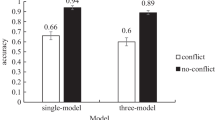Abstract
This paper addresses two problems concerning the issue of redundant information in resolution based reasoning systems. The first one deals with the question how the derivation of redundant clauses, such as duplicates or instances of already retained clauses, can be substantially reduced. The second one asks for a criterion to decide, which clauses need not be tested for redundancy. We consider a particular kind of redundancy, which we call ancestor subsumption, that is the subsumption of a resolvent by one of its ancestors. It will be shown that the occurrence of cyclic clause sets, which roughly correspond to sets of logical equivalences, accounts for ancestor subsumed resolvents. Moreover, two techniques will be given to cope with the problems caused by such cyclic structures. The first technique, called literal demodulation, uses logical equivalences as rewrite rules, the second one employs a particular kind of theory resolution.
Similar content being viewed by others
References
Bibel, W., ‘On Matrices with connections’, JACM 28/4, 633–645 (1981).
Bibel, W., Advanced Topics in Automated Deduction, Technical Report 87-39, University of Vancouver, 1987.
Guard, J. et al., ‘Semi-Automated Mathematics’, JACM 16, 49–62 (1969).
Herold, A., Some Basic Notions of First-Order Unification Theory, Internal Report, Universität Kaiserslautern, 1983.
Kapur, D. and Narendran, P., ‘NP-Completeness of the Set Unification and Matching Problems’, in: J. H. Siekmann (Ed.): Proceedings 8th International Conference on Automated Deduction, Oxford. Springer LNCS 230, 489–495 (1986).
Kapur, D. and Zhang, H., ‘RRL: A Rewrite Rule Laboratory’, In: E. Lusk and R. Overbeek (Eds.): Proc. 9th International Conference on Automated Deduction, Argonne. springer LNCS 310, 768–769 (1988).
McCune, W., ‘An Indexing Mechanism for Finding more General Formulas’, AAR Newletter 9 (1988).
McCune, W., OTTER User's Manual, Argonne Report ANL-88-44 (1988).
Ohlbach, H. J. and Siekmann, J., Using Automated Reasoning Techniques for Deductive Databases, SEKI-Report SR-88-06, Universität Kaiserslautern (1988).
Ohlbach, H. J., ‘Predicate Logic Hacker Tricks’, JAR 1/4, 435–440 (1985).
Overbeek, R., ‘An Implementation of Hyper-Resolution’, Computational Mathematics with Applications 1, 201–214 (1975).
Pelletier, F. J., ‘Seventy-five Problems for Testing Automatic Theorem Provers’, JAR 2/2, 191–216 (1986).
Quine, W. V. O., ‘On Cores and Prime Implicants of Truth Functions’, Am. Math. Monthly 66, 755–760 (1959).
Robinson, G. and Wos, L., ‘Paramodulation and theorem-proving in first-order theories with equality’, In: B. Meltzer and D. Michie (Eds.): Machine Intelligence 4. Edinburgh, 135–150 (1969).
Schmidt-Schauß, M., Some Undecidable Classes of Clause Sets, Intener Bericht, SEKI-Report 86-08, Universität Kaiserslautern (1986).
Shostak, R. E., ‘Refutation Graphs’, Artificial Intelligence 7/1, 51–64 (1976).
Shostak, R. E., A Graph-Theoretic View of Resolution Theorem-Proving, Report SRI International, Menlo Park (1979).
Smullyan, R., What is the Name of This Book, Prentice-Hall, Engelwood Cliffs, N.J. (1978).
Socher, R., ‘A Subsumption Algorithm Based on Characteristic Matrices’, In: E. Lusk and R. Overbeek (Eds.): Proc. 9th International Conference on Automated Deduction, Argonne. Springer LNCS 310, 573–581 (1988).
Socher-Ambrosius, R., Simplification and Reduction for Automated Theorem Proving, PhD thesis, University of Kaiserslautern (1990).
Stickel, M. E., ‘Automated Deduction by Theory Resolution’, JAR 1/4, 333–356 (1985).
Stickel, M. E., ‘Schubert's steamroller problem: Formulations and Solutions’, JAR 2/1, 89–102 (1986).
Vieille, L., Recursive Query Processing: The Power of Logic, ECRC Munich, Technical Report TR-KB-17 (1987).
Wos, L. et al., ‘The Concept of Demodulation in Theorem Proving’, JACM 14, 698–709 (1967).
Wos, L., Automated Reasoning: 33 Basic Research Problems. Prentice-Hall, Englewood Cliffs (1988).
Author information
Authors and Affiliations
Rights and permissions
About this article
Cite this article
Socher-Ambrosius, R. How to avoid the derivation of redundant clauses in reasoning systems. J Autom Reasoning 9, 77–97 (1992). https://doi.org/10.1007/BF00247827
Received:
Accepted:
Issue Date:
DOI: https://doi.org/10.1007/BF00247827




